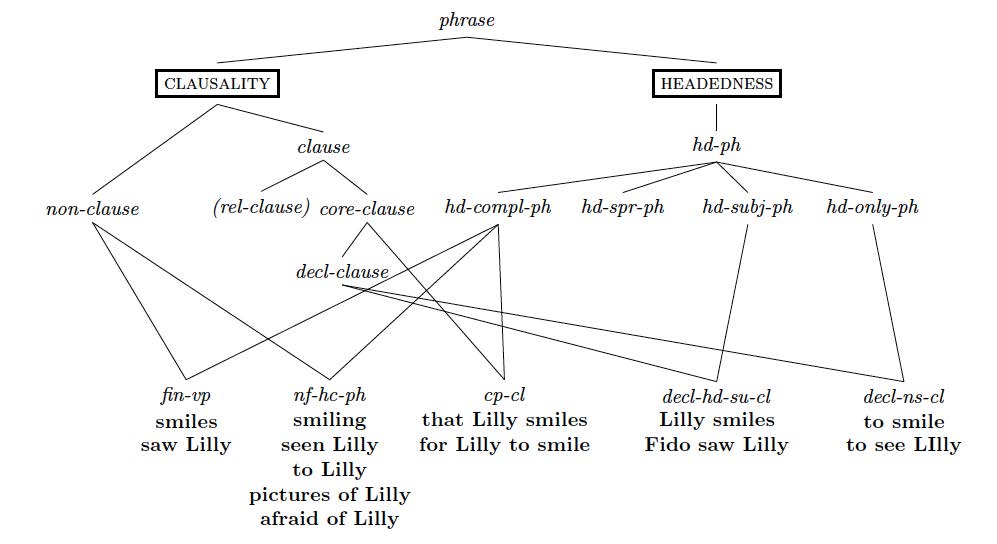Constraint-based Syntax 2: Week 3: Difference between revisions
| (9 intermediate revisions by the same user not shown) | |||
| Line 137: | Line 137: | ||
== Exercises == | == Exercises == | ||
1. Using the handout '''Phrasal Types''' | 1. Using the handout [[File:Phrasal Types.pdf|frame|'''Phrasal Types''']], compute by hand the overall constraints that the maximal subtypes of type ''phrase'' have to satisfy (leave out the type ''decl-ns-cl''). In other words: write into one feature structure all the constraints of each maximal subtype and its supertypes in the type hierarchy. | ||
2. | 2. By parsing the following expressions in the [http://141.2.159.95:7003/wt/ Schematic Grammar], you can test the constraints associated with the type ''phrase'' and its subtypes, in particular the 4 maximal types whose overall constraints you were supposed to compute by hand in Exercise 1: | ||
a. word subj_seeker<br> | a. word subj_seeker<br> | ||
b. word spr_seeker<br> | b. word spr_seeker<br> | ||
c. comp_seeker word | c. comp_seeker word<br> | ||
<br> | <br> | ||
3. | 3. By parsing the following expressions in our [http://141.2.159.95:7002/wt/ Regular Online Grammar], you will see which information authentic lexical entries contribute to a phrase: | ||
a. Real "subject seekers": | a. Real "subject seekers": | ||
| Line 164: | Line 164: | ||
After you have tried the examples above, think up 3 more examples for each of the 3 types and try them out in the regular online grammar. | After you have tried the examples above, think up 3 more examples for each of the 3 types and try them out in the regular online grammar. | ||
| Line 261: | Line 229: | ||
This is a typical modal verb. Like the other modals, it has only finite forms. Again you get two solutions, a polarized and a non-polarized one. An intriguing difference between ''will'' and the unstressed ''do'' discussed above, is that ''will'' can occur in auxiliary constructions (and then is [AUX ''plus'']), but it can also occur in constructions where main verbs can occur as well (and then, like the main verbs, will be [AUX ''minus'']. In order to be compatible with both values of the feature AUX, ''will'', it takes the neutral value [AUX ''boolean''] in its lexical entry. All verbs that can appear in auxiliary constructions except for the forms of the unstressed ''do'' behave like ''will''. | This is a typical modal verb. Like the other modals, it has only finite forms. Again you get two solutions, a polarized and a non-polarized one. An intriguing difference between ''will'' and the unstressed ''do'' discussed above, is that ''will'' can occur in auxiliary constructions (and then is [AUX ''plus'']), but it can also occur in constructions where main verbs can occur as well (and then, like the main verbs, will be [AUX ''minus'']. In order to be compatible with both values of the feature AUX, ''will'', it takes the neutral value [AUX ''boolean''] in its lexical entry. All verbs that can appear in auxiliary constructions except for the forms of the unstressed ''do'' behave like ''will''. | ||
== The Argument Realization Principle (ARP) === | |||
Recall that in GS the syntactic arguments of a word are in a sense represented twice: once on the ARG-ST (argument structure) list which, among others, is used for Binding Theory, and again on one of the valence lists SUBJ, SPR, and COMPS. Rather than being arbitrary, the relationship between the ARG-S and the valence lists is governed by the '''Argument Realization Principle''': | Recall that in GS the syntactic arguments of a word are in a sense represented twice: once on the ARG-ST (argument structure) list which, among others, is used for Binding Theory, and again on one of the valence lists SUBJ, SPR, and COMPS. Rather than being arbitrary, the relationship between the ARG-S and the valence lists is governed by the '''Argument Realization Principle''': | ||
| Line 291: | Line 254: | ||
Navigation: | Navigation: | ||
<div align="center"> | <div align="center"> | ||
[[Constraint-based_Syntax_2| '''Main page''']] [[Constraint-based_Syntax_2:_Week_1| '''Week 1''']] [[Constraint-based_Syntax_2:_Week_2| '''Week 2''']] Week 3 | [[Constraint-based_Syntax_2| '''Main page''']] [[Constraint-based_Syntax_2:_Week_1| '''Week 1''']] [[Constraint-based_Syntax_2:_Week_2| '''Week 2''']] [[Constraint-based_Syntax_2:_Week_3| '''Week 3''']] [[Constraint-based_Syntax_2:_Week_4| '''Week 4''']] [[Constraint-based_Syntax_2:_Week_5| '''Week 5''']] Week6 Week7 Week8 Week9 Week10 | ||
</div> | </div> | ||
Latest revision as of 10:02, 16 May 2017
The Phrase Hierarchy
Constraints on the Phrasal Types
Illustration of Constraint Inheritance
Since the type type{fin-vp} has several phrasal supertypes, a feature structure of that type must satisfy the following constraint:
Exercises
1. Using the handout File:Phrasal Types.pdf, compute by hand the overall constraints that the maximal subtypes of type phrase have to satisfy (leave out the type decl-ns-cl). In other words: write into one feature structure all the constraints of each maximal subtype and its supertypes in the type hierarchy.
2. By parsing the following expressions in the Schematic Grammar, you can test the constraints associated with the type phrase and its subtypes, in particular the 4 maximal types whose overall constraints you were supposed to compute by hand in Exercise 1:
a. word subj_seeker
b. word spr_seeker
c. comp_seeker word
3. By parsing the following expressions in our Regular Online Grammar, you will see which information authentic lexical entries contribute to a phrase:
a. Real "subject seekers":
- dances
- likes Lilly
b. Real "specifier seekers":
- cat
- picture of Lilly
c. Real "complement seekers":
- likes Lilly
- puts the books on the shelf
After you have tried the examples above, think up 3 more examples for each of the 3 types and try them out in the regular online grammar.
Navigation:











